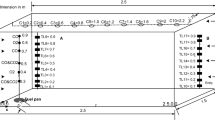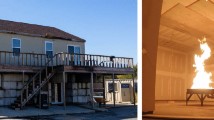Abstract
The law of fire occurring in the reaction of self-reactive substances is unique, when heated, comparing with common solid combustibles. In this paper, the possible thermal runaway reaction of Isoniazid storage was studied. Combined with the analysis of Isoniazid thermal stability characteristics, Fire Dynamics Simulator (FDS) was used to simulate the Isoniazid storage fire. The temperature distribution of Isoniazid storage was obtained. According to the simulation results, the temperature field of Isoniazid storage was analyzed by regression. The law of temperature distribution with height, time and distance from the center of ceiling was obtained. It was found that the ceiling temperature was highest at different heights. On the ceiling, the temperature was highest in the center. From the center to the sides, the temperature tended to drop. Therefore, when setting up the self-spraying fire extinguishing system, the sprinkler head protection roof needs to be set up, and for the stack center position, the sprinkler head should be protected.






Similar content being viewed by others
Abbreviations
- \({\dot{Q}}_\mathrm{in}\) :
-
The heat input
- \({\dot{Q}}_\mathrm{out}\) :
-
The heat output
- \({\dot{Q}}_\mathrm{r}\) :
-
The heat generated by itself
- \(\frac{\Delta Q}{\Delta t}\) :
-
Temperature rise
- U :
-
Total heat conductivity
- A :
-
The area of contact between sample and package
- \(T_\mathrm{c}\) :
-
The temperature of small-size sample
- \(T_\mathrm{s}\) :
-
The surface temperature of large-size stack
- \(M_\mathrm{s}\) :
-
Mass of large-size stack
- \(M_\mathrm{c}\) :
-
Mass of small sample
- \({\Delta H_\mathrm{c}}\) :
-
Reaction heat
- \(C_\mathrm{p,s}\) :
-
Specific heat capacity of large-size stack
- \(C_\mathrm{p,c}\) :
-
Specific heat capacity of small sample
- \(\alpha\) :
-
Reaction extent
- \(E_\alpha\) :
-
Activation energy
- \(A_\propto\) :
-
Preexponential factor
- R :
-
Gas constant
- \(f(\alpha )\) :
-
Reflecting the mechanism of the process
References
Frank-Kamenetskii DA, Diffusion and Heat Transfer in Chemical Kinetics. 2nd Ed. Translated from Russian by J. P. Appleton, Plenum Press, New York, p 375 (1969).
Brown ME, Maciejewski M, Vyazovkin S, Nomen R, Sempere J, Burnham A, Opfermann J, Strey R, Strey R, Anderson HL, Kemmler A, Kueleers R, Janssens J, Dessseyn HO, Li C-R, TangTong B, Roduit B, Malek J, Mitsuhashi T. Computational aspects of kinetic analysis. Part A: the ICTAC kinetics project-data, methods and results. Thermochim Acta. 2000;355:125–43.
Dellavedova M, Pasturenzi C, Gigante L, Lunghi A. Kinetic evaluations for the transportation of dangerous chemical compounds. Chem Ing Trans. 2012;26:85–90.
Roduit B, Hartmann M, Folly P, Sarbach A, Brodard P, Baltensperger R. Determination of thermal hazard from DSC measurements. Investigation of self-accelerating decomposition temperature (SADT) of AIBN. J Therm Anal Calorim. 2014;117(3):1017–26.
Miyake A, Kimura A, Ogawa T, Satoh Y, Inano M. Thermal hazard analysis of hydrazine and nitric acid mixtures. J Therm Anal Calorim. 2005;80(2):515–8.
Porob Reema A, Khan SZ, Mojumdar SC, Verenkar VMS. Synthesis, TG, DSC and infrared spectral study of NiMn2(C4H4O4)3·6N2H4. J Therm Anal Calorim. 2006;86(3):605–8.
Wedlich RC, Davis DD. Non-isothermal kinetics of hydrazine decomposition. Thermochimica Acta. 1990;171(1):1–13.
Vyazovkin S, Chrissafis K, Di Lorenzo ML, Koga N, Pijolat M, Roduit B, et al. Ictac kinetics committee recommendations for collecting experimental thermal analysis data for kinetic computations. Thermochimica Acta. 2014;590:1–23.
Guo S, Wan W, Chen C, Chen WH. Thermal decomposition kinetic evaluation and its thermal hazards prediction of AIBN[J]. J Therm Anal Calorim. 2013. https://doi.org/10.1007/s10973-013-2993-7.
Liu Y, Yang Q, Chen LP, He ZQ, Lu Y, Chen WH. Thermal sensitivity of energetic materials characterized by accelerating rate calorimeter (ARC). Chin J Energy Mater. 2011;19:656–60.
Zhang GY, Jin SH, Li LJ, Li YK, Wang DQ, Li W, Zhang T, Shu QH. Thermal hazard assessment of 4,10-dinitro-2,6,8,12-tetraoxa-4,10-diazaisowurtzitane (TEX) with accelerating rate calorimeter (ARC). J Therm Anal Calorim. 2016;126:467–71.
Linteris G, Katta V, Takahashi F. Experimental and numerical evaluation of metallic compounds for suppressing cup-burner flames. Combust Flame. 2004;138(1):78–96.
Xu Q, Griffin G, Jiang Y, Preston C, Bicknell A, Bradbury G, et al. Study of burning behavior of small scale wood crib with cone calorimeter. J Therm Anal Calorim. 2008;91(3):787–90.
Ferng Y-M, Liu C-H. Numerically investigating fire suppression mechanisms for the water mist with various droplet sizes through FDS code. Nucl Eng Des. 2011;241(8):3142–8.
Chi J-H. Using thermal analysis experiment and fire dynamics simulator (FDS) to reconstruct an arson fire scene. J Therm Anal Calorim. 2013;113(2):641–8.
Zhang S, Ni X, Zhao M, et al. Numerical simulation of wood crib fire behavior in a confined space using cone calorimeter data. J Therm Anal Calorim. 2015;119(3):2291–303.
Roduit B, Hartmann M, Folly P, Sarbach A, Brodard P, Baltensperger R. Thermal decomposition of AIBN, Part B: Simulation of SADT value based on DSC results and large scale tests according to conventional and new kinetic merging approach. Thermochimica Acta. 2015;621:6–24.
Dragoe N, Segal E. Pseudo-inverse matrix method—a direct method for non-isothermal kinetic analysis. J Therm Anal Calorim. 1998;54(3):931–5.
Zhang CY, Jin SH, Chen SS, Li LJ, Zhou C, Zhan Y, Shu QH. Thermal behavior and thermo-kinetic studies of 5,5′-bistetrazole-1,1′-diolate (1,1-BTO). J Therm Anal Calorim. 2017;129:1265–70.
Roduit B, Xia L, Folly P, Berger B, Mathieu J, Sarbach A, et al. The simulation of the thermal behavior of energetic materials based on dsc and hfc signals. J Therm Anal Calorim. 2008;93(1):143–52.
Author information
Authors and Affiliations
Corresponding author
Additional information
Publisher's Note
Springer Nature remains neutral with regard to jurisdictional claims in published maps and institutional affiliations.
Rights and permissions
About this article
Cite this article
Jiang, Hl., Zhang, Sh. Isoniazid thermal runaway simulation based on ARC data. J Therm Anal Calorim 145, 3133–3140 (2021). https://doi.org/10.1007/s10973-020-09939-7
Received:
Accepted:
Published:
Issue Date:
DOI: https://doi.org/10.1007/s10973-020-09939-7




